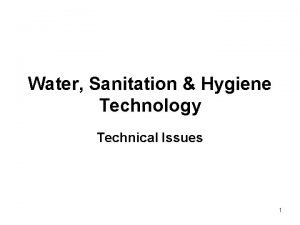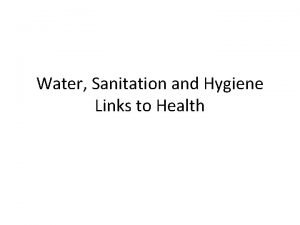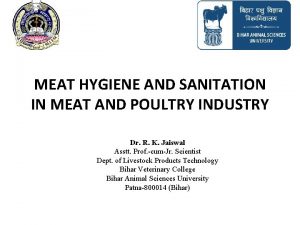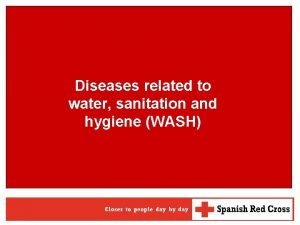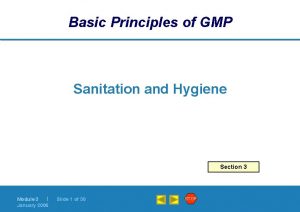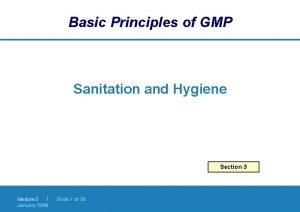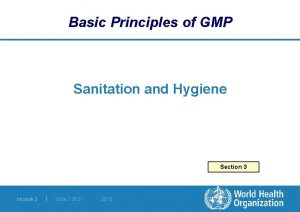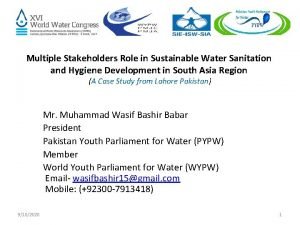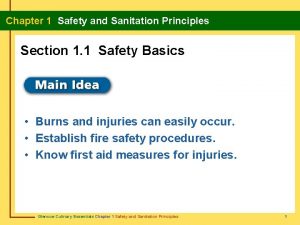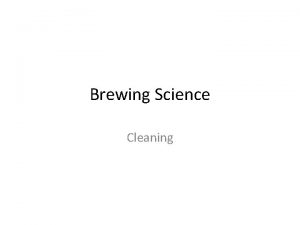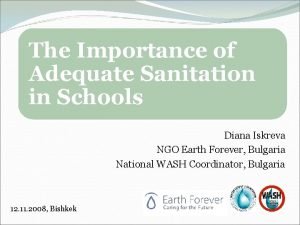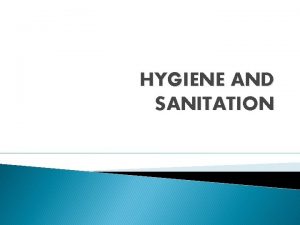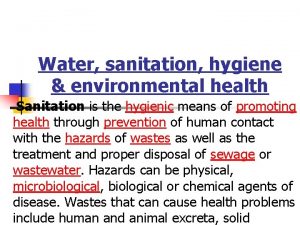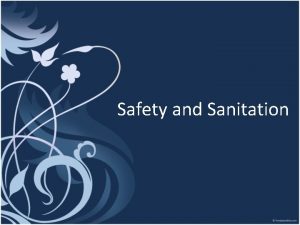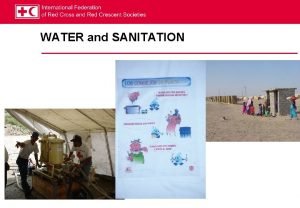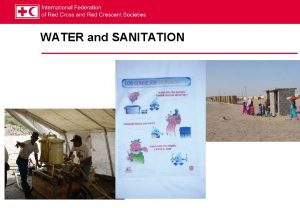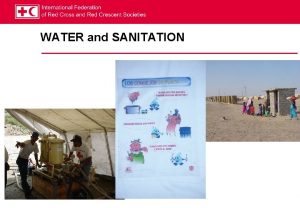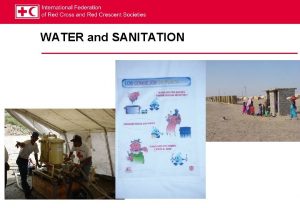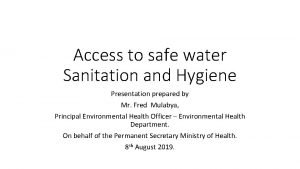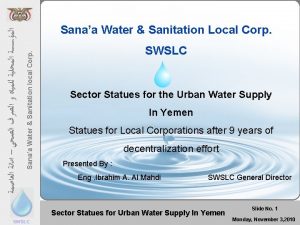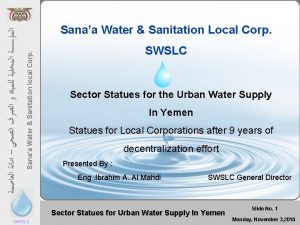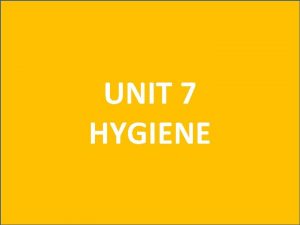Monitoring access to water sanitation and hygiene for














- Slides: 14

Monitoring access to water, sanitation and hygiene for people with disabilities Rob Bain, UNICEF Rifat Hossain, WHO 3 rd May, 2016

SDG WASH targets and indicators Target: By 2030, achieve universal and equitable access to safe and affordable drinking water for all Indicator: Percentage of population using safely managed drinking water services Target: By 2030, achieve access to adequate and equitable sanitation and hygiene for all and end open defecation, paying special attention to the needs of women and girls and those in vulnerable situations Indicator: Percentage of population using safely managed sanitation services including hand washing facilities with soap and water 2

Safely managed drinking water Progressive realization On premises, available when needed and meets water quality standards Basic water Improved facility within 30 minutes round trip collection time Unimproved water Facility which does not protect against contamination No service Surface water Monitoring ladder Developed Service ladder Developing MDG continuity SDG 6. 1 MDG/SDG All developed countries, and some developing countries Most developing and some developed countries report All countries report (applies to developing countries) 3

Monitoring ladder Basic sanitation Private basic sanitation Most developing and some developed countries report Improved sanitation Most developing and some developed countries report Shared sanitation Unimproved sanitation No service Fixed point defecation Open defecation Developed Safely managed sanitation Beyond basic sanitation facility, safe disposal of fecal wastes on site, or transport and treatment off-site Developing MDG continuity SDG 6. 2 MDG/SDG Service ladder Progressive realization All developed countries, some developing countries All countries report (applies to developing countries) All countries report (applies to some countries) 4

SDG targets…'leave no one behind' • Disaggregate as relevant – income, – sex, – age, – race, – ethnicity, – migratory status, – disability and – geographic location, – or other characteristics of national relevance • Target elements – Universal – equitable – safe – affordable – adequate – open defecation, – women and girls – vulnerable situations 5

Inequalities are intersectional § The SDGs must go beyond identifying inequality by wealth quintiles § The world’s poorest are disproportionately characterized by one or several exclusionary or discriminatory grounds Caste Ethnicity Gender Disability § Laws, policies, lengthy administrative procedures can also negatively impact on access to water and sanitation services. § Eg. People with disabilities are socially excluded unless special policies ensure their access in public spaces

Incorporating disaggregated indicators § The human rights to water and sanitation and the human rights principles of non-discrimination and equality inform the framework for monitoring inequalities § The END Working Group suggests a metric comparing advantaged groups with disadvantaged groups. in the following areas of monitoring: 1. 2. 3. 4. Wealth quintile analysis Geographic disparities a) rural-urban b) intra-urban Group-related inequalities (e. g. based on race, ethnicity and migratory status) Intra-household inequalities (e. g. based on sex, age and disability) § Service provision must also be monitored in institutions, the workplace and public spaces

Progressive elimination of inequalities = Progressive realisation of human rights § Progress among both groups can be followed. Disparity should decrease through time § The world’s most disadvantaged groups must be given priority Access (%) Advantaged group 2015 Disadvantaged group 2020 2025 2030 8

Priorities and way forward… Disaggregation Priority for WASH SDG Priority for JMP In collaboration with External collaboration Income (WQ) Yes HHS Affordability Yes WB, HHS Sex Yes UNWOMEN, IAEG-gender Race, ethnicity, religion, education… Yes Thematic IER, etc. Academia Migratory status Yes (? ) TBC Academia Disability (incl age) Yes Disability com TBC Subnational (NTD, nutrition), informal urban Yes UNHABITAT Extra household Yes WHO, UNICEF Academia 9

Data: world health surveys in 2003/2004 • World Report on Disability used data from World Health Surveys from 50 countries. • JMP analysis: difference in access between household with people with and without disability (35 countries) • Disability: present data does not provide a clear picture of the nature or scale of this inequality • Quantifying differential access within households is difficult. 10

Data: world health surveys in 2003/2004 25% Access to improved sanitation: disability gap (% pt) namibia • World Report on Disability used data from World Health Surveys from 50 countries. • JMP analysis: difference in access between household with people with and without disability (35 countries) • Disability: present data does not provide a clear picture of the nature or scale of this inequality • Quantifying differential access within households is difficult. 20% zambia kenya 15% vietnam 10% bangladesh latvia swaziland senegal ethiopia tunisia malawi srilanka india burkina mali lao southafrica morocco guatemala nepal myanmar ecuador philippines paraguay malaysia russia croatia kazakhstan zimbabwe mexico ghana czech 5% 0% 0% 2% chad china uae 4% 6% 8% 10% 12% 14% Access to improved water: disability gap (% pt) 16% 18% 11

Data: 2010 census round in Latin America In households with and without a disabled person, water and sanitation coverage appears to be similar Country Indicator Disabled National Costa Rica CEN 2011 Improved water Improved sanitation 95 97 Ecuador CEN 2010 Improved water Improved sanitation 81 77 83 79 Mexico CEN 2010 Improved water Improved sanitation 93 82 93 84 Panama CEN 2010 Improved water Improved sanitation 92 69 93 70 (any disability) (“permanent” disability) (physical or mental) (any disability in list) Definitions of disabled vary between these censuses No information on specific barriers for people with disabilities only access at the household-level 12

Inclusive and accessible WASH • • Inclusive, consultative, participatory with persons with disabilities Confronting both societal barriers of access and technical/physical barriers © UNICEF Guyana 13

Conclusions • SDG – “for all” and ambition to leave no one behind must include people with disabilities • There are specific barriers to WASH faced by people with disabilities at home and away from home • Inclusive design with participatory processes can ensure accessibility for people with disabilities. • Household-level monitoring insufficient and specific questions would need to be asked of people with disabilities • The JMP is keen to collaborate with the disability community to explore innovative means of monitoring WASH access 14
 Sanitation and hygiene
Sanitation and hygiene Sanitation and hygiene
Sanitation and hygiene Poultry hygiene and sanitation
Poultry hygiene and sanitation Sanitation and hygiene
Sanitation and hygiene Gmp sanitation and hygiene
Gmp sanitation and hygiene Gmp sanitation and hygiene
Gmp sanitation and hygiene Gmp sanitation and hygiene
Gmp sanitation and hygiene Water and water and water water
Water and water and water water Stakeholders in water and sanitation
Stakeholders in water and sanitation Chapter 1 safety and sanitation principles
Chapter 1 safety and sanitation principles Cleaning and sanitation manual for breweries
Cleaning and sanitation manual for breweries Compendium of sanitation systems and technologies
Compendium of sanitation systems and technologies Concept school
Concept school Delvic sanitation initiatives
Delvic sanitation initiatives 7 steps of dry sanitation
7 steps of dry sanitation
